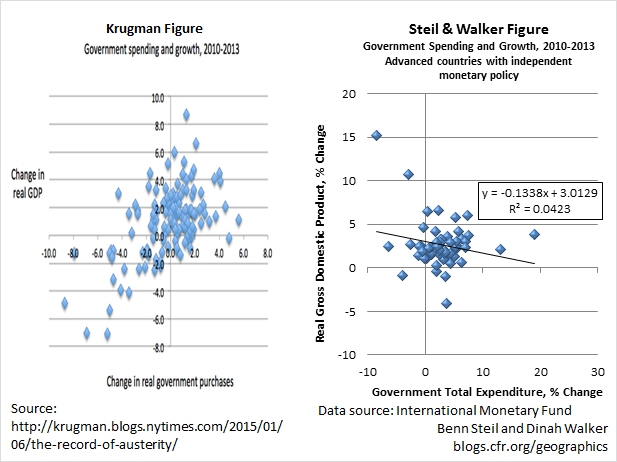Correcting Paul Krugman’s Austerity Chart for Monetary Effects Yields Very Different Results
More on:

In two recent blog posts (1/6 and 1/7), Paul Krugman highlighted a chart he made that, he says, illustrates clearly the failure of “austerity” around the world. We reproduce it above on the left.
Krugman’s chart plots changes in real GDP against changes in real government purchases for 33 advanced countries between 2010 and 2013. The slope of the trend line (which Krugman does not draw) is clearly positive (with R-squared of 0.31), suggesting strongly that cutting government spending (during that period) reduced growth, and that raising it increased growth.
The problem with this figure is that it mixes countries that were able to use monetary policy with those that weren’t – such as those in the Eurozone or those with hard currency pegs. Referring to this problem, Scott Sumner recently asked on his blog: “Why do Keynesians show cross-sectional graphs of fiscal austerity and growth, mixing in countries that have their own independent monetary policy with those that do not?” Sumner’s point is that countries that have independent monetary policy can, in principle, offset fiscal drag with more accommodative monetary policy. Is he right?
On the right-hand figure above, we re-did Krugman’s chart for advanced countries with independent monetary policies. Lo and behold, Krugman’s spending-growth relationship collapses, as Sumner would have expected.
This is not to say that austerity is good. But it does undermine the empirical basis for Krugman’s claim that reducing government spending lowers growth, and that increasing government spending raises growth, at least in countries that can use monetary policy as well as fiscal policy.
Follow Benn on Twitter: @BennSteil
Follow Geo-Graphics on Twitter: @CFR_GeoGraphics
Read about Benn’s latest award-winning book, The Battle of Bretton Woods: John Maynard Keynes, Harry Dexter White, and the Making of a New World Order, which the Financial Times has called “a triumph of economic and diplomatic history.”
More on:
 Online Store
Online Store
